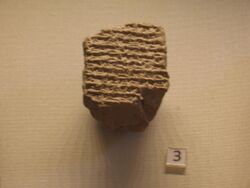Babylonian astronomical diaries
Topic: Astronomy
 From HandWiki - Reading time: 2 min
From HandWiki - Reading time: 2 min
The Babylonian astronomical diaries are a collection of Babylonian cuneiform texts that contain systematic records of astronomical observations and political events as well as predictions, based on astronomical observations. They also include other information such as commodity prices for particular dates and weather reports.[1][2]
Currently, they are stored in the British Museum.
It is suggested that the diaries were used as sources for the Babylonian Chronicles.
History
The Babylonians were the first to recognise that astronomical phenomena are periodic and to apply mathematics to their predictions.[3] The oldest known significant astronomical text is Tablet 63 of the Enûma Anu Enlil collection, the Venus tablet of Ammisaduqa, which lists the first and the last visible risings of Venus over a period of about 21 years. It is the earliest evidence that planetary phenomena were recognised as periodic.
The systematic records of ominous phenomena in astronomical diaries began during the reign of Nabonassar (747–734 BC), when a significant increase in the quality and frequency of astronomical observations occurred. That allowed, for example, the discovery of a repeating 18-year Saros cycle of lunar eclipses.[4]
Translation
Translations of the Diaries are published in multivolume Astronomical Diaries and Related Texts from Babylonia, edited by Abraham Sachs and Hermann Hunger.[1][2][5]
- Volume I – Diaries from 652 B.C. to 262 B.C. (ISBN:3-7001-1227-0, 1988).
- Volume II – Diaries from 261 B.C. to 165 B.C. (ISBN:3-7001-1705-1, 1989).
- Volume III – Diaries from 164 B.C. to 61 B.C. (ISBN:3-7001-2578-X, 1996).
- Volume IV – Undated Diaries and Addenda (ISBN:978-3-7001-9032-5, 2022).
- Volume V – Lunar and Planetary Texts (ISBN:3-7001-3028-7, 2001), contains lunar and planetary data from the 8th century BC to the 1st century BC.
- Volume VI – Goal Year Texts (ISBN:978-3-7001-3727-6, 2006), contains lunar and planetary data, from the 3rd century BC to the 1st century BC.
- Volume VII – Almanacs and Normal Star Almanacs (ISBN:978-3-7001-7627-5, 2014), contains astronomical almanacs, from the 3rd century BC to the 1st century AD.
References
- ↑ 1.0 1.1 Geller, M. J. (1990). "Babylonian Astronomical Diaries and Corrections of Diodorus". Bulletin of the School of Oriental and African Studies, University of London 53 (1): 1–7. doi:10.1017/s0041977x00021212.
- ↑ 2.0 2.1 Rochberg-Halton, F. (1991). "The Babylonian Astronomical Diaries". Journal of the American Oriental Society 111 (2): 323–332. doi:10.2307/604022.
- ↑ Steele, John (2019-06-01). "Explaining Babylonian Astronomy". Isis 110 (2): 292–295. doi:10.1086/703532. ISSN 0021-1753. https://www.journals.uchicago.edu/doi/full/10.1086/703532.
- ↑ A. Aaboe; J. P. Britton; J. A. Henderson; Otto Neugebauer; A. J. Sachs (1991). "Saros Cycle Dates and Related Babylonian Astronomical Texts". Transactions of the American Philosophical Society (American Philosophical Society) 81 (6): 1–75. doi:10.2307/1006543. "One comprises what we have called "Saros Cycle Texts," which give the months of eclipse possibilities arranged in consistent cycles of 223 months (or 18 years).".
- ↑ Astronomical Diaries and Related Texts from Babylonia, Abraham Sachs and Hermann Hunger (eds.), Wien, Austrian Academy of Sciences.
External links
- Astronomical Diaries: article at livius.org
- Links to translations of Astronomical Diaries: for 333-63 B.C.
 |
 KSF
KSF
